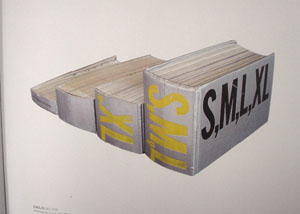Posts Tagged ‘jose davila’
Book Arts

Jose Dávila, S,M,L,XL 2000
A Boing Boing post last week featured book sculptor Brian Dettmer’s work. It got me thinking about another artist, Jose Dávila. I came across Dávila’s work while researching criticism of Rem Koolhaas’ mega-book S,M,L,XL. When Koolhaas created S,M,L,XL, he encouraged criticism of the publication as vulgar and confusing; that was the point. Nonetheless, the book was often written off as extravagant and empty.
Dávila was one of the more offended critics. His reaction to the book involved its destruction for the purpose of his art. As an artist fascinated with the political conceptual art of the 60s and 70s, his work sought emphemerality, was site-specific and irreproducible. Dávila was convinced that theories of dematerialization were best conveyed not in the creation of books, but in their demolition. For a project, he sliced S,M,L,XL into four pieces, each ranging in size from small, medium, large and extra-large pieces. Taking S,M,L,XL as the quintessence of the state of the art book publishing, Dávila conveyed his discontent by rendering the book useless as anything but a sculptural object.
To him, even intact, the big books of art and architecture were unable to achieve a non-sculptural importance as the books were “expensive, over-designed publications that are usually entirely devoid of content.” This reception of S,M,L,XL is troubling because Dávila construes the wealth of content in the book (which could even be considered as too much) as nothing. While he has duly noted that the image rich publications like those of Koolhaas and Bruce Mau (graphic designer and co-author of S,M,L,XL) “sacrifice readability for the sake of flashing design, he neglects to engage the compromised readability for a productive result. Complicated doesn’t always equal unusable.
Dávila cannot counterbalance the book’s artistic merit with its role as commodified object. In referring to the book as an unreadable prop, he is basically refusing to consider anything other than the black text on white paper in non-descript covers as books. S,M,L,XL is a legitimate manifesto, and the hallmark essay “Bigness” is frequently cited in architecture and urban planning texts. Part of the brilliance of S,M,L,XL and certainly integral in its success is the harmonious embodiment of aesthetic object and useful object. And because many critics encountered an entirely new and not readily understandable form in S,M,L,XL, their reactions only scratched the surface of the work’s complexities.